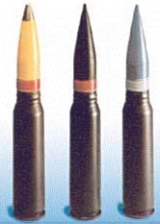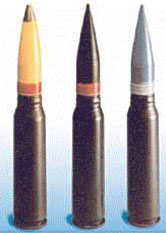
High explosive incendiary
Encyclopedia
In war
fare, High-explosive incendiary (HEI) is a type of ammunition
specially designed to pierce armor, fragment, and ignite readily combustible materials.
High Explosive Incendiary shells (HEIS) are designed to penetrate the armor of the target using high explosive properties, and then fragment and flare up, causing a fire either inside or outside of the target. HEI shells have been in use with numerous countries since the invention of the modern howitzer
.
HEI ammunition is fuse
d either mechanically or chemically. The armor-piercing ability can vary widely, allowing for more focused fragmentation or larger scatter.
cannon
, howitzer
and naval artillery
. Currently, HEI rounds are most commonly made in medium-caliber sizes of 20 mm, 25 mm, and 30 mm. They are fired from various platforms, including aircraft, anti-aircraft cannons, and anti-missile systems
, as well as common battlefield howitzer
s, though the latter has gone through a recent decline in use.
HEI ammunition has also been used on the battlefield against tanks and other armoured vehicles, but this has become impractical due to the invention of modern armour systems such as Chobham
and explosive reactive armour, which can absorb most high-explosive rounds currently used.
Recently, APIS (armour piercing incendiary shells) have been used; these penetrate the target using the kinetic properties
of the round before the incendiary round goes off, smothering the crew in flames, cooking off
ammunition and igniting combustible materials, generally destroying the target.
 The shells were first employed in naval batteries
The shells were first employed in naval batteries
, but soon found their way to land-based howitzers as well. They caused fires, which on ships can be difficult to extinguish in the tight spaces. Also, fired at tanks and soft target
s, they can cause fires that completely engulf the vehicle, killing anyone inside.
Occasionally HEIS were used against tanks and other lightly armoured vehicles, but, since the invention of modern battle armour, such as Chobham
, and Explosive Reactive Armour, these shells have become less and less practical for anti-tank work, and more useful for destroying “soft” targets such as air bases, trench
es, or bunker
s, in which they can create fires of over 1000 degrees Celsius. Incendiary shells are no longer in use by many countries, due to bans on the use of phosphorus weapons
.
Armor-piercing shot and shell
penetrate the target using kinetic energy
before the incendiary charge ignites, smothering the crew in flames, detonating ammunition, and destroying the target.
War
War is a state of organized, armed, and often prolonged conflict carried on between states, nations, or other parties typified by extreme aggression, social disruption, and usually high mortality. War should be understood as an actual, intentional and widespread armed conflict between political...
fare, High-explosive incendiary (HEI) is a type of ammunition
Ammunition
Ammunition is a generic term derived from the French language la munition which embraced all material used for war , but which in time came to refer specifically to gunpowder and artillery. The collective term for all types of ammunition is munitions...
specially designed to pierce armor, fragment, and ignite readily combustible materials.
High Explosive Incendiary shells (HEIS) are designed to penetrate the armor of the target using high explosive properties, and then fragment and flare up, causing a fire either inside or outside of the target. HEI shells have been in use with numerous countries since the invention of the modern howitzer
Howitzer
A howitzer is a type of artillery piece characterized by a relatively short barrel and the use of comparatively small propellant charges to propel projectiles at relatively high trajectories, with a steep angle of descent...
.
HEI ammunition is fuse
Fuse (explosives)
In an explosive, pyrotechnic device or military munition, a fuse is the part of the device that initiates function. In common usage, the word fuse is used indiscriminately...
d either mechanically or chemically. The armor-piercing ability can vary widely, allowing for more focused fragmentation or larger scatter.
History
HEI ammunition was originally developed for use in large-caliberCaliber
In guns including firearms, caliber or calibre is the approximate internal diameter of the barrel in relation to the diameter of the projectile used in it....
cannon
Cannon
A cannon is any piece of artillery that uses gunpowder or other usually explosive-based propellents to launch a projectile. Cannon vary in caliber, range, mobility, rate of fire, angle of fire, and firepower; different forms of cannon combine and balance these attributes in varying degrees,...
, howitzer
Howitzer
A howitzer is a type of artillery piece characterized by a relatively short barrel and the use of comparatively small propellant charges to propel projectiles at relatively high trajectories, with a steep angle of descent...
and naval artillery
Artillery
Originally applied to any group of infantry primarily armed with projectile weapons, artillery has over time become limited in meaning to refer only to those engines of war that operate by projection of munitions far beyond the range of effect of personal weapons...
. Currently, HEI rounds are most commonly made in medium-caliber sizes of 20 mm, 25 mm, and 30 mm. They are fired from various platforms, including aircraft, anti-aircraft cannons, and anti-missile systems
Close-in weapon system
A close-in weapon system , often pronounced sea-whiz, is a naval shipboard point-defense weapon for detecting and destroying at short range incoming anti-ship missiles and enemy aircraft which have penetrated the outer defenses....
, as well as common battlefield howitzer
Howitzer
A howitzer is a type of artillery piece characterized by a relatively short barrel and the use of comparatively small propellant charges to propel projectiles at relatively high trajectories, with a steep angle of descent...
s, though the latter has gone through a recent decline in use.
HEI ammunition has also been used on the battlefield against tanks and other armoured vehicles, but this has become impractical due to the invention of modern armour systems such as Chobham
Chobham armour
Chobham armour is the name informally given to a composite armour developed in the 1960s at the British tank research centre on Chobham Common, Surrey, England...
and explosive reactive armour, which can absorb most high-explosive rounds currently used.
Recently, APIS (armour piercing incendiary shells) have been used; these penetrate the target using the kinetic properties
Kinetic energy penetrator
A kinetic energy penetrator is a type of ammunition which, like a bullet, does not contain explosives and uses kinetic energy to penetrate the target....
of the round before the incendiary round goes off, smothering the crew in flames, cooking off
Cooking off
Cooking off refers to ammunition exploding prematurely due to heat in the surrounding environment. It can also refer to a technique used when throwing grenades to achieve a controlled, predictable explosion....
ammunition and igniting combustible materials, generally destroying the target.
Employment

Naval artillery
Naval artillery, or naval riflery, is artillery mounted on a warship for use in naval warfare. Naval artillery has historically been used to engage either other ships, or targets on land; in the latter role it is currently termed naval gunfire fire support...
, but soon found their way to land-based howitzers as well. They caused fires, which on ships can be difficult to extinguish in the tight spaces. Also, fired at tanks and soft target
Soft target
Soft target is a military term referring to unarmored/undefended targets needing to be destroyed. For example, a soft target would be an automobile, a house, or assembly of people while a hard target could be a main battle tank or a well defended installation...
s, they can cause fires that completely engulf the vehicle, killing anyone inside.
Occasionally HEIS were used against tanks and other lightly armoured vehicles, but, since the invention of modern battle armour, such as Chobham
Chobham armour
Chobham armour is the name informally given to a composite armour developed in the 1960s at the British tank research centre on Chobham Common, Surrey, England...
, and Explosive Reactive Armour, these shells have become less and less practical for anti-tank work, and more useful for destroying “soft” targets such as air bases, trench
Trench
A trench is a type of excavation or depression in the ground. Trenches are generally defined by being deeper than they are wide , and by being narrow compared to their length ....
es, or bunker
Bunker
A military bunker is a hardened shelter, often buried partly or fully underground, designed to protect the inhabitants from falling bombs or other attacks...
s, in which they can create fires of over 1000 degrees Celsius. Incendiary shells are no longer in use by many countries, due to bans on the use of phosphorus weapons
White phosphorus (weapon)
White phosphorus is a material made from a common allotrope of the chemical element phosphorus that is used in smoke, tracer, illumination and incendiary munitions. Other common names include WP, and the slang term "Willie Pete," which is dated from its use in Vietnam, and is still sometimes used...
.
Armor-piercing shot and shell
Armor-piercing shot and shell
An armor-piercing shell is a type of ammunition designed to penetrate armor. From the 1860s to 1950s, a major application of armor-piercing projectiles was to defeat the thick armor carried on many warships. From the 1920s onwards, armor-piercing weapons were required for anti-tank missions...
penetrate the target using kinetic energy
Kinetic energy
The kinetic energy of an object is the energy which it possesses due to its motion.It is defined as the work needed to accelerate a body of a given mass from rest to its stated velocity. Having gained this energy during its acceleration, the body maintains this kinetic energy unless its speed changes...
before the incendiary charge ignites, smothering the crew in flames, detonating ammunition, and destroying the target.
See also
- HEIAP High Explosive Incendiary/Armor Piercing AmmunitionHigh Explosive Incendiary/Armor Piercing AmmunitionHigh Explosive Incendiary/Armor Piercing Ammunition is a form of shell which combines both an armor-piercing capability and a high-explosive effect. In this respect it is a modern version of armor piercing shell...

